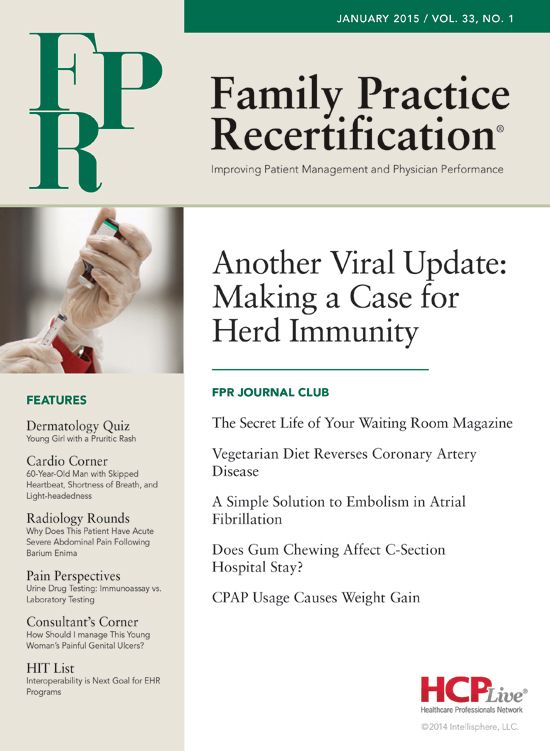Publication
Article
Family Practice Recertification
Another Viral Update: Making a Case for Herd Immunity
Author(s):
Another viral outbreak has hit the United States causing fear and hysteria as well as action from public health officials. The index case for this outbreak occurred in my home state, California, and its spread has far exceeded that seen with Ebola virus.

Another viral outbreak has hit the United States causing fear and hysteria as well as action from public health officials. The index case for this outbreak occurred in my home state, California, and its spread has far exceeded that seen with Ebola virus.
As of January 18, 2015, 51 individuals who visited Disneyland between December 17 and 20 have been infected and the number continues to rise. Of the confirmed cases, 45 cases are in California, 2 in Utah and Washington, and one in Colorado and Mexico. Unlike Ebola virus, this virus is extremely contagious, spreading by aerosol transmission 3 to 4 days before the telltale rash appears.
Patients are infectious during this early phase of the illness while suffering from symptoms indistinguishable from a cold. The only saving grace is that this virus is nowhere as deadly as Ebola virus which has a mortality rate as high as 60%. Although the case-fatality rate for this virus is only 0.3%, it is nonetheless a serious viral illness (requiring hospitalization in up to 20% of cases). It also does not have a specific treatment, and can cause birth defects as well as long-term sequelae (including subacute sclerosing panencephalitis). The name of this virus? Rubeola, better known as “measles”.
How did this happen? Although successfully eliminated in the United States in 2000 thanks to the widespread measles vaccination, until the past half-decade, measles cases in the United States were relatively uncommon and occurred primarily in foreign visitors or unvaccinated Americans exposed to measles abroad.
Thanks to “herd immunity” facilitated by state-implemented mandatory school vaccination laws and federally-funded childhood vaccination programs, measles infections were quickly contained by being surrounded by a ring of people previously immunized.
Although the concept of “herd immunity” is accepted as a critical public health goal, it is being threatened by a growing number of families opting out of vaccinating their children. Although many parents decline vaccinations based on religious concerns, many more opt out based on philosophical reasons and misinformation about the risks of vaccination and unfamiliarity of the severity of the diseases vaccines are designed to protect against.
This has led to a steady decline in vaccination rates, with rates in some states falling below critical levels required for “herd immunity” for the DPT and MMR vaccines and kindergarten measles vaccination rates in California falling almost every year since 2002.
The outbreak in California stemmed from what might be regarded as a “perfect storm”. The index case occurred at Disneyland, a national and international destination that brings together in a “petri-dish”-like setting of up to 40,000 visitors each day. The introduction of a single case of measles into this setting thereby has resulted in exposure not only to susceptible persons in the park but also potential further spread into the communities where infected park visitors live.
In an effort to stem the outbreak, local public health officials have resorted to case-tracking and have advised parents that unvaccinated children be excluded from school or day care for 21 days if exposed to measles, to prevent further spread of disease. Although restrictive public health measures were criticized in the Ebola scare last year, such measures are perfectly appropriate and necessary for a highly communicable, airborne infection such as measles.
Although parents have every right to decide whether or not to immunize their children, it is imperative that they make this decision based on the best-available evidence and with full awareness of the implications it holds not for their children but also for susceptible individuals (who either cannot be vaccinated or whose vaccination failed) in their communities. For those parents still deciding against immunization, full cooperation and compliance with quarantines and any other public health measures deemed necessary to protect the public is required.
As physicians, it is important that we effectively communicate this message and to identify and address any concerns the parents may have. In addition, although many have never seen an actual case of measles, physicians and other healthcare professionals need to consider this diagnosis when evaluating patients with febrile rash and to ask about a patient's recent travel history and contact with individuals who have recently traveled abroad.
The United States experienced a record number of measles cases during 2014, with 644 cases from 27 states reported to the CDC; this represents the greatest number of cases since the elimination of measles in the U.S. in 2000. If the level of protection afforded by herd immunity continues to wane and current public health policy prove ineffective, more restrictive, pre-emptive, and what likely would be perceived as draconian measures may be on the horizon.
Editor's Note:A story on CNN.com noted that by the end of January there had been 102 cases of the measles in 14 states. Most of those cases were linked to Disneyland cases.

2 Commerce Drive
Cranbury, NJ 08512
All rights reserved.





